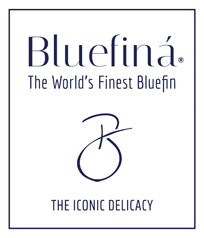If you’ve ever tried sushi, the chances are high that you’ve had tuna; however, are you also aware that there are different types of tuna to choose from? In most sushi restaurants, one of two types of tuna is on offer: yellowfin tuna, a fish known as ‘ahi’ (“ah-hee”), and bluefin tuna, also known as maguro in Japanese, from which we get toro sushi.
Because of its exclusivity on the market, toro prices have increased to be one of the most expensive items on the menu, and with its buttery, melt-in-your-mouth texture, it’s not difficult to see why.
Parts of Tuna
In true Japanese style, no part of the fish is wasted. There are multiple bluefin tuna cuts, so let’s dive a little deeper into each one:
The Head
The head of the tuna is usually separated into four subtypes; the upper head, the cheeks, the jaw, and the eyes. The whole head can be used in a dish called Kabutoyaki, which has a striking visual impact on the diner.
Kama
Kama refers to the flesh around the gills, of which there are only two pieces that can be cut from each fish. The fattiest part, found within the kama, is called the kamatoro. The rich fat content of this cut gives the fish a marbled appearance, much like what you would see on a prized cut of beef. Kama is usually cooked in dishes, whereas kamatoro is traditionally reserved for sashimi or sushi.
Otoro
Otoro is known for its exceptional, distinctive fat marbling and is located on the fattiest part of the tuna, the underbelly. This cut is found between the harakami (the part of the abdomen close to the gills) and the haranaka (center of the belly). It’s considered the fattiest of the bluefin tuna cuts and has that melt-in-your-mouth effect when eaten.
Chutoro
This cut can be found on both the back and the underside of the fish and is divided into four subtypes:
- sekami – the part of the back near the head
- senaka – the center of the back
- seshimo – the part closest to the tail
- harashimo – a section found on the harakami near the tail.
Chutoro (choo-toh-roh) is considered the more affordable cut than the otoro, as it still has a bit of marbling but is not as rich as the otoro.
Akami
Akami (ah-kah-me) is the meat from the center of the fish. It’s the leanest of all the cuts, so if you are not keen on fatty tuna, then this is the cut you might like.
The Tail
Also a very fatty part of the tuna. This cut is often used in stews or cut into steaks.
It’s All in the Taste
But what does toro taste like? Many who try toro for the first time fall in love with it instantly for its complete rich and creamy, melt-in-your-mouth extravaganza.
If toro is not for you, then you may enjoy the slightly less fatty, but equally as great tasting, Chutoro we mentioned above.
How to Make Toro Sushi
This buttery cut of tuna is perfect for making sushi and now that we know a little more about the different parts of the tuna, and the different bluefin tuna cuts, let’s dive into making your own toro sushi!
Sashimi and Nigiri sushi are the most common uses for toro, so let’s look at making Nigiri.
Ingredients:
- Short grain sushi rice, cooked
- Restaurant-quality toro
- Soy Sauce
- Wasabe
- Yuzu
- Pickled ginger
Method
To begin, prepare the sushi rice to package instructions. If you’re unsure how to make sushi rice, take a quick look at these instructions.
Next, prepare your toro by trimming the piece into a rectangle and removing the skin (this can be kept for other dishes if wanted).
Now you’ll want to sear the tuna using a kitchen blowtorch if you have one. This step is not mandatory, but lightly searing the tuna melts some of the fat-releasing oils, which gives the tuna a unique and delicious umami flavor and is highly recommended. Again, you’re looking for a whitish sear all around the trimmed piece.
Once seared, cut into slices. It is recommended to cut these thinly due to the high-fat content of the delicate flesh.
Once that is done, you’ll want to shape the rice in preparation: take a small (golf ball size) amount of sushi rice in your right hand, and with the fingers on your left hand, shape the ball into an elongated shape. Using your thumb, gently press an indent into the bottom of the rice, and shape the top into a hump.
Finally, take a slice of seared toro and gently lay the piece on top of the bed of rice you just made. Press gently with your fingers to adhere the fish to the rice.
Repeat for as many nigiri as you like.
If you prefer, squeeze a bit of yuzu on top to further enhance the flavor. Serve your toro sushi with soy sauce, wasabi, and pickled ginger on the side.
Environmental Factors of Bluefin Tuna
In 2004-2005, it was found that the population of Pacific Bluefin tuna was decreasing rapidly due to the increasing demand for this delectable fish. There was then a concerted effort by the commercial fishing industry, along with fisheries scientists and NGOs, to protect this majestic and valuable tuna species. This included the introduction of reduced capture quotas, 100 percent traceability, and verifications to help protect the tuna.
You can read more about our sustainability practices here.
Restaurant-Quality Toro Sushi
There is no bigger restaurant faux-pas than having low-quality ingredients. That’s why it’s best to source only the finest grade Pacific Bluefin tuna, which are naturally fed with no growth hormones, antibiotics, or additives.
We pride ourselves on ethical capture quotas and 100% traceability, making our Pacific Bluefin tuna the responsible choice for any high-end establishment.
Contact us for more information on how you can supply your customers with the finest restaurant-quality sushi available.




